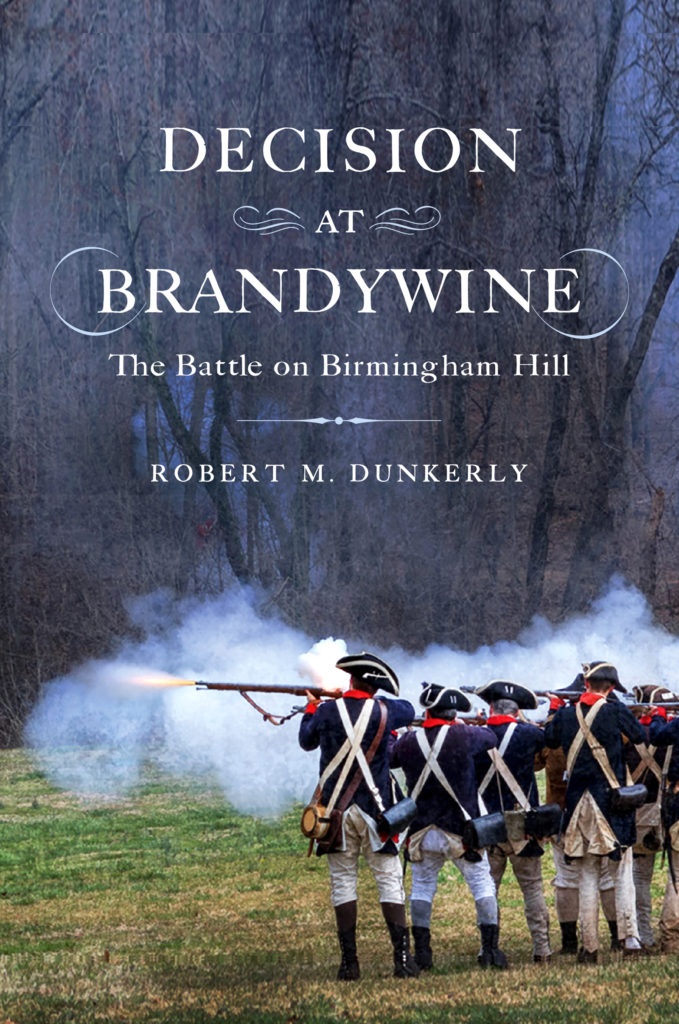

Decision at Brandywine
The Battle on Birmingham Hill
Select Your Format:
Paperback$28.00Hardback
$30.00 Add to Cart Save 25% on every book by joining our Book Club


Select Your Format:
PaperbackA detailed study of the turning point in one of the most important battles in American history
The Battle of Brandywine, fought on September 11, 1777, along its namesake creek in the bucolic Pennsylvania countryside, was one of the largest engagements of the Revolutionary War. To those who participated in this massive battle, spread out over ten square miles and lasting from late afternoon until dark, it was unforgettable. Soon after the action, Major Joseph Bloomfield of the 3rd New Jersey recorded that it was “the grandest scene I ever saw, a sight beyond description.” Brandywine was the first major battle for the recently reorganized Continental Army. Units had fought in small engagements, but not until Brandywine did the army fight as a whole against the British. As the two armies clashed, a ferocious and desperate action developed on a hill at the heart of the battlefield, and it was here where the battle’s outcome was determined.
Despite its size and significance—Brandywine was the third bloodiest engagement of the war, with 1,300 American and 581 British casualties—the battle has been subject to very few studies. In Decision at Brandywine: The Battle on Birmingham Hill, historian Robert M. Dunkerly analyzes the fighting near the Birmingham Meeting House where the battle turned. By dissecting the struggle on Birmingham Hill in detail, he offers a case study in weapons, tactics, and terrain analysis critical to a holistic understanding of the entire battle and what it would mean for the future of the Continental Army. In the process he not only explains how the Continental Army’s lack of uniformed training and inexperience in large open-field battles played a major role in their defeat, but also provides important information about Revolutionary War combat in general.

ROBERT M. DUNKERLY is a historian, award-winning writer, and Park Ranger at Richmond National Battlefield Park. He holds a BA in history from St. Vincent College and an MA in historic preservation from Middle Tennessee State University. He has worked at fourteen historic sites, written over a dozen books and numerous scholarly articles, and has taught courses at Central Virginia Community College and the University of Richmond.
“Dunkerly describes the units involved, American and British, and their background, training and experience. The course of the combat is detailed, relying heavily on eyewitness accounts. Among those, he has mined hundreds of American revolutionary pension applications. . . . This slim volume is a good introduction to the battle.”—Journal of America’s Military Past
“Decision at Brandywine offers a detailed analysis of the battlefield that hosted the notorious American defeat. Dunkerly sets out to examine how the Continental army trained and equipped itself leading up to the battle. After explaining the historical and global influences on the various fighting styles of the Continental army, Dunkerly gives reads a play-by-play analysis of the Battle of Brandywine by weaving together soldiers’ accounts, troop returns, and commanders’ correspondence. Dunkerly concludes with a chapter about how Washington applied lessons learned at Brandywine to standardizing his army, followed by an analysis of historic preservation efforts related to the battle. Dunkerly outlines a turning point in the development of the Continental army while using photos, maps, and a range of written primary sources to provide readers with an intimate look at how soldiers experienced Brandywine. . . . Early American historians should take this book as another signal of the invaluable trove of information related to the lived experience of warfare available from park rangers.”—Journal of Military History
“In this text, Dunkerly offers a new lens through which to view the Battle of Brandywine—its core engagement at Birmingham Hill—from the point of view of the soldiers themselves. Rife with primary sources, Dunkerly’s work presents, in welcome detail, a regiment-by-regiment account of this watershed engagement. What emerges is a more holistic analysis not just of the battle itself, but of its drama, confusion, and lasting importance to Washington’s Continental Army. Dunkerly draws a clear line from lessons learned by the patriots’ defeat at Brandywine to the Continental Army’s eventual victory over the world’s most seasoned professional army, and makes a compelling case for the necessity of detailed battle analysis such as this.”—Katherine Gruber, historian, Jamestown-Yorktown Foundation
“In Decision at Brandywine, historian Robert Dunkerly offers an exciting, detailed, but easy-to-follow account and analysis of what was arguably the critical point at Brandywine, which determined the outcome of the crucial September 11, 1777 battle.”—Glenn F. Williams, author of Dunmore’s War: The Last Conflict of America’s Colonial Era
“This superb account of the Battle of Brandywine is provided by noted historian Robert Dunkerly. His broad knowledge was gained through his detailed study of the ground on which the fighting took place and by his research of the personal accounts of the soldiers who survived this deadly fight on September 11, 1777. Read this excellent account of the close-quarters struggle between the armies of Generals George Washington and Sir William Howe and then explore the battlefield for yourself.”—Brig. Gen. John W. Mountcastle, U.S. Army (Ret.) former Army Chief of Military History